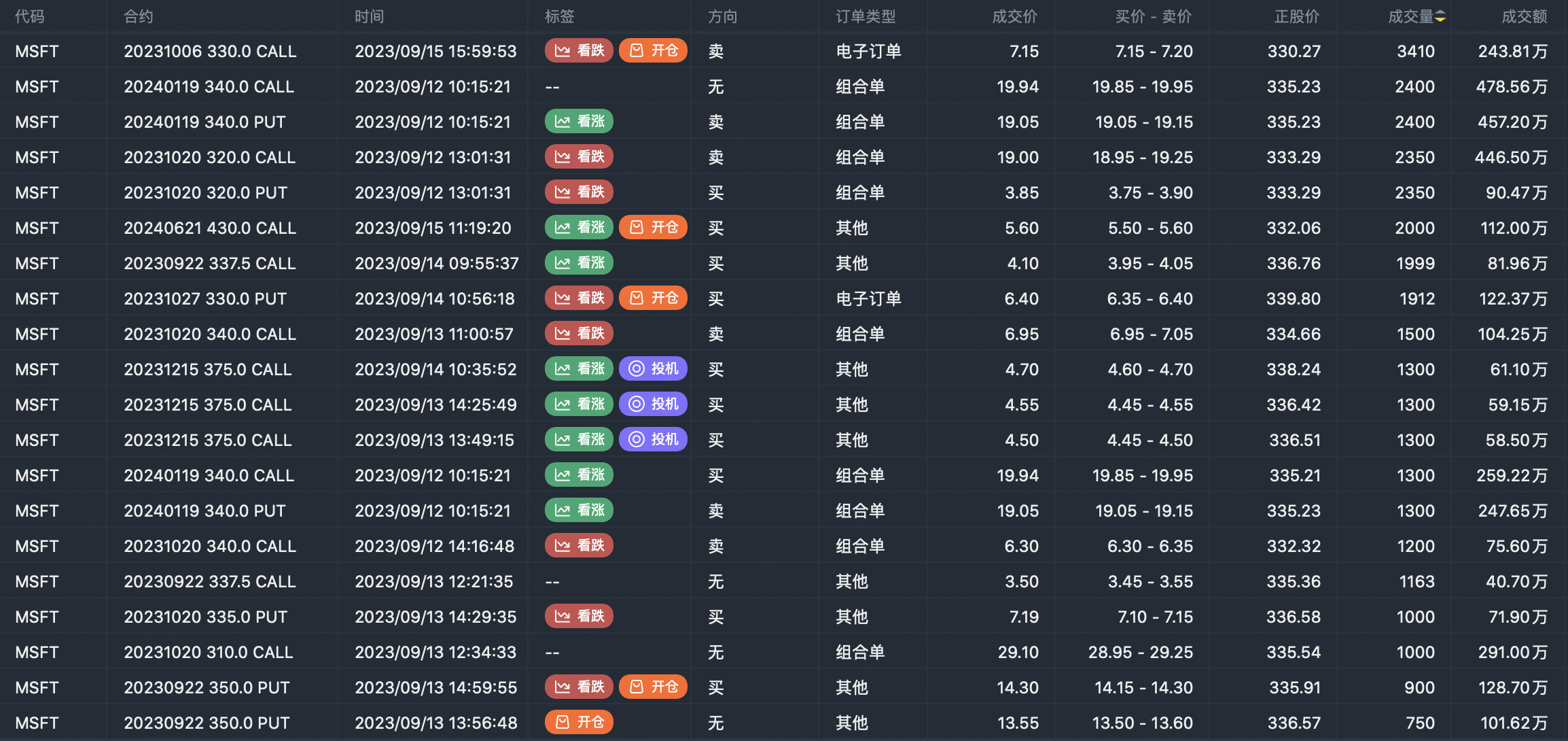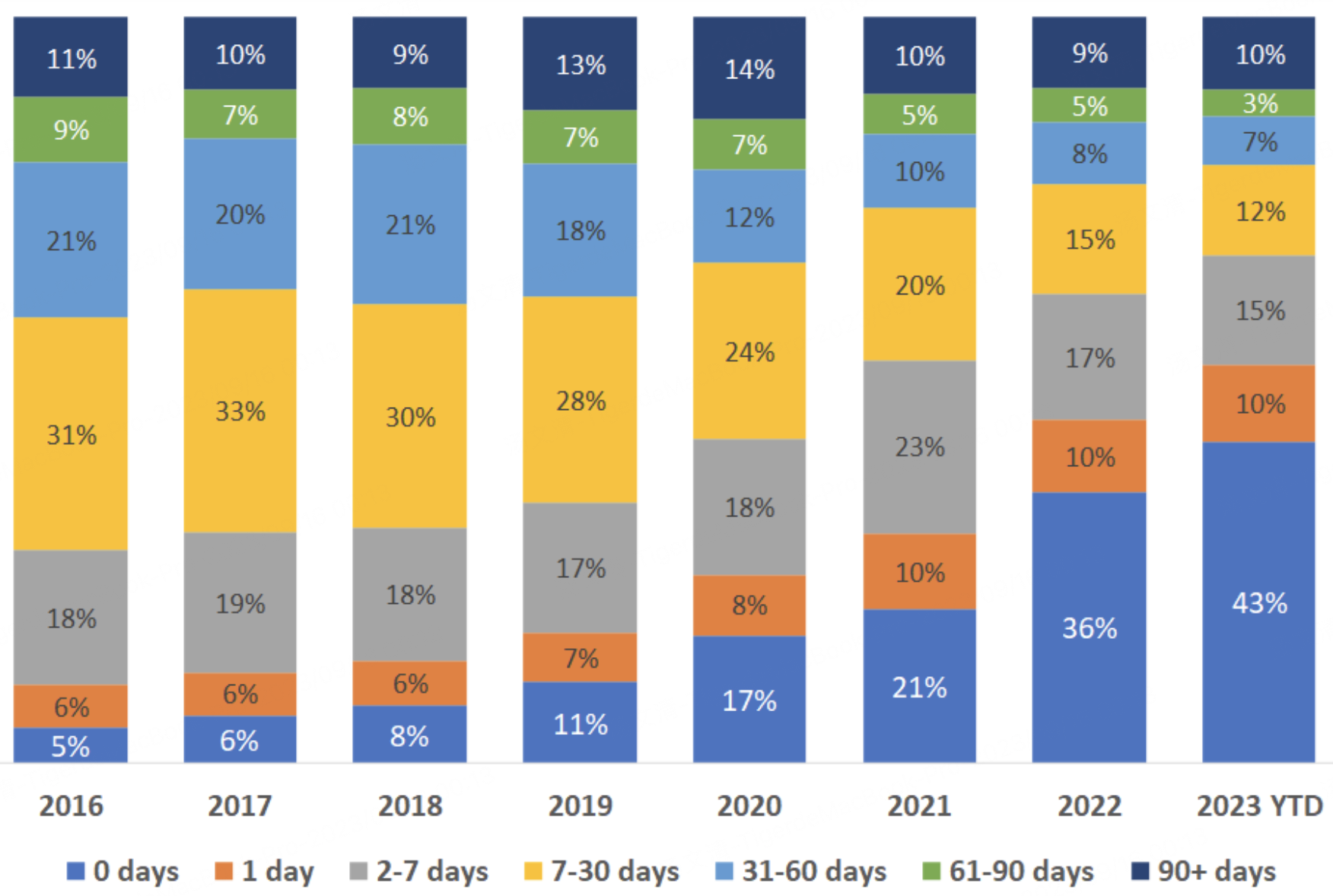Is it time to be optimistic? 0DTE options trading strategy is packaged as an ETF
At present, the market is in a bold and conservative state, and the bulls and bears are engaged in a fierce game on the last rate hike. For now, the bears are winning.
It can be expected that the Fed will not raise interest rates at this FOMC meeting, and the focus is on Powell's attitude: will there be a last rate hike in November. Powell would have one of three attitudes: raise rates, no rate hike, depends on the data. I am more inclined to the third attitude, from the expiry date of the large option order, the institution also believes that the turning point of the small correction market is in the non-agricultural farm on October 6:
The expiration date of the call option sold just before the close on Friday revealed a lot $MSFT 20231006 330.0 CALL$ . Institutions bet $100 million on the belief that the market will not improve before the non-farm, Microsoft will not exceed 330.
Why is this turning point the non-farm data release day? You may remember what happened in August when the NFP was released, and there were significant downward revisions to the NFP data for July and June, from 187,000 to 157,000, and from 185,000 to 105,000 in June, for a total of 110,000.
If nothing else, there will be a big downward revision this time, and the market must expect the Fed to step down and the last rate hike to go away.
Two things stood out last week as the market became impatient and aggressive again due to the downward revision of September's non-farm data. The first is the listing of chip giant $ARM Holdings Ltd(ARM)$ , which is valued at more than $50 billion. The second is the launch of a 0DTE Options ETF, the S&P 500 Enhanced Options Income ETF $Defiance Nasdaq 100 Enhanced Options Income ETF(QQQY)$ . The latter is the subject of the rest of this article.
Options Income ETF
Options income ETFs are nothing new, such as covered call ETFs:
$NASDAQ 100 Covered Call ETF(QYLD)$
$JPMorgan Equity Premium Income ETF(JEPI)$
$YIELDMAX TSLA OPTION INCOME STRATEGY ETF(TSLY)$ (Tesla individual stock covered call ETF)
Sell put ETFs:
$WISDOMTREE PUTWRITE STRATEGY FUND(PUTW)$
These options income ETFs are based on the proven strategies we use to achieve more stable returns and lower volatility. QQQY uses a different strategy, or one that hasn't caught on in our community yet: sell ATM 0DTE puts.
0DTE
0DTE stands for zero days to expiry options. However, foreign media have widely used this concept, and options expiring that week can also be counted as 0DTE.
The popularity of 0DTE is not due to individual stocks, but to the SPX. In early 2016, the CME introduced SPX weekly options expiring on Wednesday, followed by options expiring on Monday. Options expiring in the current week of the 2022 SPX were increased to every day of the trading day, Monday through Friday, opening the door for market participants to trade and hedge with the precision of a hand surgeon. In 2023, SPX 0DTE options trading accounted for about 43% of average daily volume (ADV).
Then this unexplored "blue ocean" was taken up by a small fund company.
Defiance ETFs, which manages 0DTE options, is a small Miami-based thematic fund with five ETFs worth $860m. QQQY's sister product, the Defiance S&P 500 Enhanced Options Income ETF (JEPY), will debut on the Cboe BZX Exchange this week.
For his 0DTE fund, the CEO said that "selling short-term options multiple times produces a higher yield than selling fewer long-term options." After their backtesting, the strategy generated double-digit returns in backtesting, and the concept "far outperformed the covered call strategy by 2.5% to 3% per year."
A steady strategy?
The reputation of0DTE option is not very good in the community at home and abroad, and mentioning 0DTE option is serious gambling.
But the fact that the CEO of Defiance can confidently disclose the return of the backtest shows that they have found a strategy for stable profitability of 0DTE options, so what?
Generally speaking, there are three common strategies for 0DTE: 1, pure buy, 2, vertical spread, 3, iron condor.
1) Buy put or call options. Buy call or put options directly to hedge or speculate on short-term market movements.
2) Vertical spreads, usually by selling vertical spread options, selling call spreads or selling put spreads.
3) Iron condor, that is, sell bullish vertical + sell bearish vertical combination. For example, if you have a neutral outlook on the stock and believe that the stock price will be range-bound in the short term, then it is most appropriate to sell the iron condor.
According to the CBOE report, about 45-50 percent of the trades are side trades, which include existing side trades where end users adjust open positions. 50-55% are spread trades, about a third are vertical spreads, and the rest are made up of more complex trading structures (butterflies, iron vultures, ratio spreads, etc.).
But the Defiance ETFs strategy is unusual in that it uses a strategy of selling at-the-money or in-the-money puts. According to the prospectus, the Fund will sell put options on a daily basis that are either priced at the current price (at-the-money options) or priced at up to 5% of the current price (i.e., 5% in-the-money options). This strategy provides the fund with the opportunity to earn time decay, and these sold puts have an expiration date ranging from one day to one week at the time of trading.
For example, suppose the fund sells an in-the-money put with a strike price of 105 when the index is at 100. If the index rises to 105 before the expiration date, the fund will earn royalties from the sale of options. It will also benefit slightly from the extrinsic value of the current put option. That is, if a put option is sold at 0.50% of its time value, the option in this example gains 0.5 more.
As with selling a put option, there is a cap on the payoff. If the index increases by more than 105, the fund will not have any additional increase. In addition, if the index is below 100 at expiration, minus the time value of the put option, the fund loses money.
It is important to note, however, that the fund only intends to invest in cash-settled options, meaning that option holders will not receive securities when the options are exercised or expire. Instead, all transactions are paid for in cash.
Bull confidence for market
Going back to the beginning of this article, you can see why I said that the market is in a state of aggressive and conservative.
If it is the kind of bear market in 2022, I think Defiance ETFs are never dare to put up this pure sell put strategy ETF. For this product, the industry is very straightforward to say that the fund 'bets' on the market going up more times than it goes down, and down more times than up, and the portfolio manager will have to buy back the short put option at a loss.
In other words, the CEO of Defiance ETFs is very optimistic about the continuation of the bull market and does not care about the short-term pullback, so he dared to go public with ARM on the same day. For 0DTE trading, on the basis of a bull market and a stable win rate, selling at-the-money options is indeed the easiest way to make money, which we will discuss in detail in the next article.
Disclaimer: Investing carries risk. This is not financial advice. The above content should not be regarded as an offer, recommendation, or solicitation on acquiring or disposing of any financial products, any associated discussions, comments, or posts by author or other users should not be considered as such either. It is solely for general information purpose only, which does not consider your own investment objectives, financial situations or needs. TTM assumes no responsibility or warranty for the accuracy and completeness of the information, investors should do their own research and may seek professional advice before investing.



Shareholders own less than 10% with ARM. ARM is worth at most $10.12, their book value. Shareholders less than 10% ownership is practically worthless imo. How can anyone think this company is worth $60 and more per share? Those are the numbers I found.
$纳斯达克100 Covered Call ETF-Global X(QYLD)$ I understand how this doesn't get much upside from selling calls but how can this be down 30 percent in 5 years but the index be up 85 over 5 that seems extreme no? that's 115 percent difference
$ARM Holdings Ltd(ARM)$ I knew it would go back down. I’ll wait until $15
what the heck..., these losses shouldn't be happening with QYLD... thinking of dumping my shares and moving to something less reckless....
Great ariticle, would you like to share it?
my goodness, I have too much QYLD at 17.5